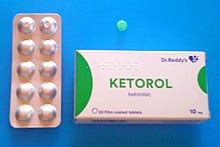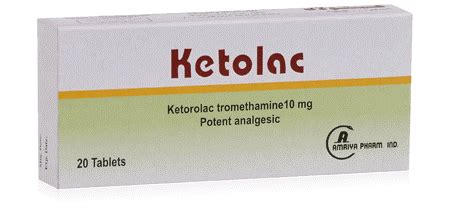Intro
Discover ketorolac uses and benefits for pain relief, inflammation reduction, and more, exploring its efficacy as an NSAID for treating conditions like arthritis, migraines, and post-surgery discomfort.
Pain management is a crucial aspect of healthcare, and various medications are available to alleviate different types of pain. One such medication is Ketorolac, a nonsteroidal anti-inflammatory drug (NSAID) that has been widely used for its effectiveness in managing moderate to severe pain. Understanding the uses and benefits of Ketorolac is essential for both healthcare professionals and patients to make informed decisions about its use.
Ketorolac has been approved by the FDA for the short-term management of moderate to severe pain, typically for a period of up to five days. It works by inhibiting the production of prostaglandins, which are chemicals in the body that cause pain and inflammation. By reducing the production of these chemicals, Ketorolac helps to alleviate pain and reduce inflammation. Its effectiveness in pain management has made it a popular choice among healthcare providers for treating various conditions, including post-operative pain, dental pain, and pain associated with musculoskeletal injuries.
The benefits of using Ketorolac for pain management are numerous. One of the primary advantages is its rapid onset of action, which provides quick relief from pain. Additionally, Ketorolac has been shown to be effective in reducing the need for opioid medications, which can be habit-forming and have serious side effects. This makes it an attractive option for patients who are at risk of developing opioid dependence or those who have a history of substance abuse. Furthermore, Ketorolac is available in various formulations, including oral, intramuscular, and intravenous, making it convenient for use in different clinical settings.
Ketorolac Mechanism of Action

Ketorolac works by inhibiting the enzyme cyclooxygenase (COX), which is responsible for the production of prostaglandins. Prostaglandins are chemicals that cause pain, inflammation, and fever. By blocking the production of these chemicals, Ketorolac reduces the inflammation and pain associated with various conditions. The mechanism of action of Ketorolac is similar to that of other NSAIDs, but its potency and duration of action are distinct. Understanding the mechanism of action of Ketorolac is essential for healthcare providers to use it effectively and minimize its potential side effects.
Ketorolac Uses

Ketorolac has several uses in the management of pain. Some of the most common uses include:
- Post-operative pain management: Ketorolac is often used to manage pain after surgery, particularly for procedures that involve moderate to severe pain.
- Dental pain management: Ketorolac is effective in reducing pain associated with dental procedures, such as tooth extractions or oral surgery.
- Musculoskeletal pain management: Ketorolac is used to manage pain associated with musculoskeletal injuries, such as strains, sprains, or fractures.
- Cancer pain management: Ketorolac may be used to manage pain associated with cancer, particularly in patients who are at risk of developing opioid dependence.
Ketorolac Administration
Ketorolac can be administered through various routes, including oral, intramuscular, and intravenous. The choice of administration route depends on the clinical setting and the patient's condition. Oral administration is commonly used for outpatient management of pain, while intramuscular and intravenous administration are often used in hospital settings.Ketorolac Benefits

The benefits of using Ketorolac for pain management are numerous. Some of the most significant benefits include:
- Rapid onset of action: Ketorolac provides quick relief from pain, which is essential for managing acute pain.
- Effective pain relief: Ketorolac has been shown to be effective in reducing pain associated with various conditions, including post-operative pain, dental pain, and musculoskeletal pain.
- Reduced need for opioids: Ketorolac can reduce the need for opioid medications, which can be habit-forming and have serious side effects.
- Convenience: Ketorolac is available in various formulations, making it convenient for use in different clinical settings.
Ketorolac Side Effects
Like all medications, Ketorolac can cause side effects. Some of the most common side effects include: * Nausea and vomiting * Dizziness and drowsiness * Headache and fatigue * Stomach upset and diarrhea * Increased risk of bleedingKetorolac Contraindications

Ketorolac is contraindicated in certain patients, including:
- Patients with a history of asthma, urticaria, or allergic reactions to NSAIDs
- Patients with active peptic ulcer disease or gastrointestinal bleeding
- Patients with severe kidney or liver disease
- Patients who are at risk of developing opioid dependence or those who have a history of substance abuse
Ketorolac Interactions
Ketorolac can interact with other medications, including: * Warfarin and other anticoagulants * Aspirin and other NSAIDs * Lithium and other mood stabilizers * Methotrexate and other chemotherapeutic agentsKetorolac Dosage

The dosage of Ketorolac depends on the clinical setting and the patient's condition. The typical dosage range is:
- Oral: 10-20 mg every 4-6 hours as needed
- Intramuscular: 15-30 mg every 6 hours as needed
- Intravenous: 15-30 mg every 6 hours as needed
Ketorolac Precautions
Ketorolac should be used with caution in certain patients, including: * Elderly patients * Patients with kidney or liver disease * Patients who are at risk of developing opioid dependence or those who have a history of substance abuseKetorolac Warnings

Ketorolac carries several warnings, including:
- Increased risk of bleeding
- Gastrointestinal perforation and ulceration
- Kidney and liver damage
- Allergic reactions and anaphylaxis
Ketorolac Patient Education
Patients should be educated about the proper use of Ketorolac, including: * Dosage and administration * Potential side effects and interactions * Contraindications and precautions * Importance of follow-up appointments and monitoringKetorolac Storage and Disposal

Ketorolac should be stored in a cool, dry place, away from direct sunlight and moisture. Patients should be instructed on the proper disposal of unused or expired medication.
Ketorolac Conclusion and Future Directions
In conclusion, Ketorolac is a potent NSAID that is effective in managing moderate to severe pain. Its benefits include rapid onset of action, effective pain relief, and reduced need for opioids. However, it carries several warnings and precautions, including increased risk of bleeding, gastrointestinal perforation, and kidney and liver damage. Further research is needed to fully understand the benefits and risks of Ketorolac and to develop new formulations and administration routes that can improve its safety and efficacy.What is Ketorolac used for?
+Ketorolac is used for the short-term management of moderate to severe pain, typically for a period of up to five days.
How does Ketorolac work?
+Ketorolac works by inhibiting the production of prostaglandins, which are chemicals in the body that cause pain and inflammation.
What are the benefits of using Ketorolac?
+The benefits of using Ketorolac include rapid onset of action, effective pain relief, and reduced need for opioids.
What are the potential side effects of Ketorolac?
+The potential side effects of Ketorolac include nausea and vomiting, dizziness and drowsiness, headache and fatigue, stomach upset and diarrhea, and increased risk of bleeding.
Can Ketorolac be used in patients with kidney or liver disease?
+Ketorolac should be used with caution in patients with kidney or liver disease, as it can worsen these conditions.
In summary, Ketorolac is a valuable medication for managing moderate to severe pain. Its benefits and risks should be carefully considered, and patients should be educated on its proper use and potential side effects. By understanding the uses and benefits of Ketorolac, healthcare providers can make informed decisions about its use and improve patient outcomes. We invite readers to share their thoughts and experiences with Ketorolac in the comments section below. If you found this article informative, please consider sharing it with others who may benefit from this information.
